To mark the centenary of the death, on 13 February 1921, of one of Girton’s longest serving Mistresses, Elizabeth Welsh, we present an exhibition of her life and work in College, curated by Hazel Mills (Historian) and Hannah Westall (Archivist).
Exhibition
Elizabeth Welsh (1843–1921)
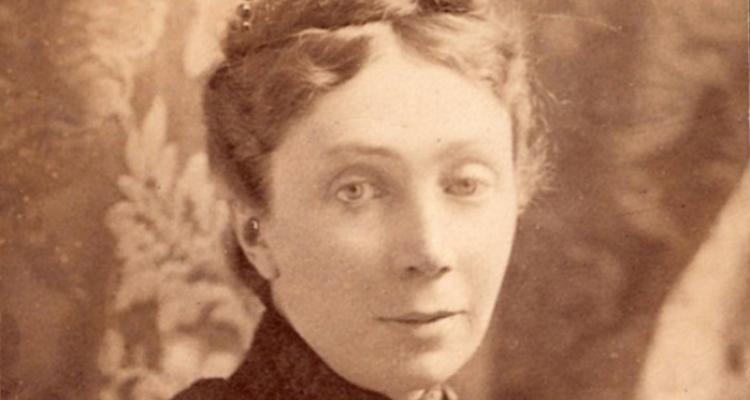
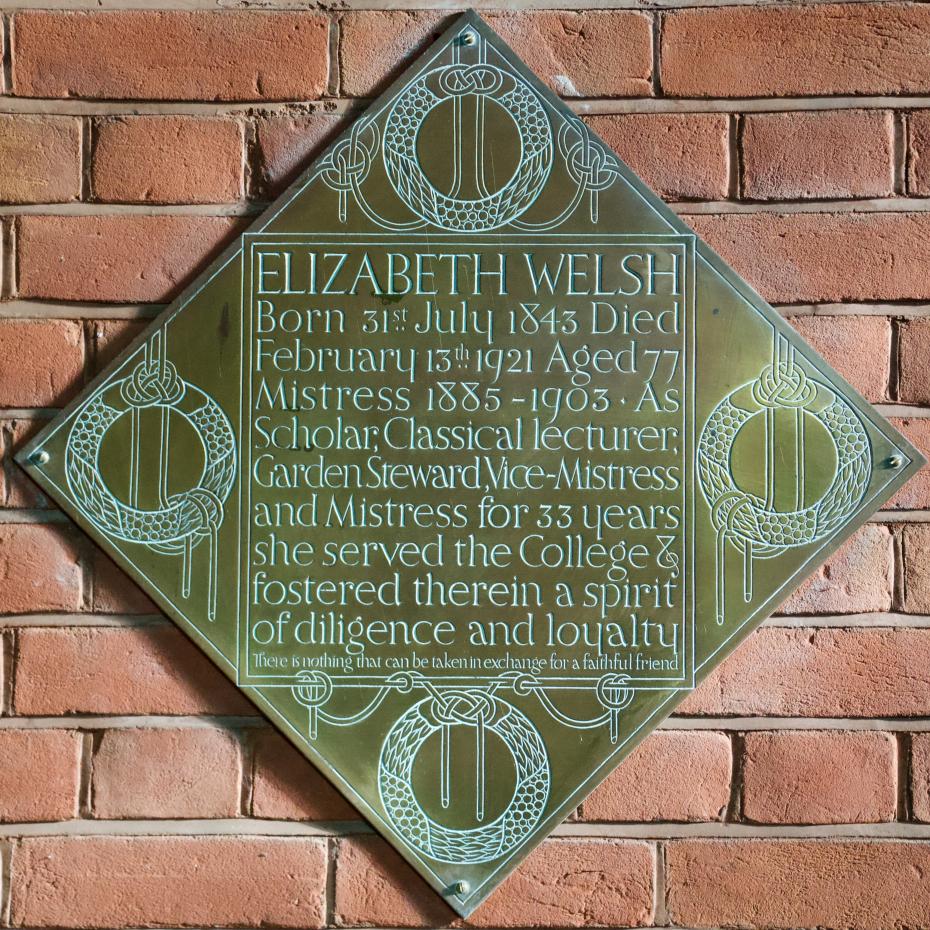
Elizabeth Welsh Memorial Plaque, Girton College Chapel (photograph by Jeremy West)
She was a person of excellent intellectual endowment, a real lover of learning and books, and she had an inborn talent for finance. She was of unflagging industry, had a great sense of responsibility, was exquisitely orderly and admirably punctual. Miss Welsh was, moreover, very “good company,” and had a true gift of Irish humour. She never bored one. She had also a gift of verse, and wrote some of the best among the much treasured “College Songs,” and was an admirable letter writer.
– EE Constance Jones (1848–1922, Mistress 1903–1916)
Elizabeth Welsh was the sixth Mistress of the College and the first Girtonian to be Mistress. In total she would spend 31 years at the College – 4 as a student; 9 as Resident Lecturer in Classics, 18 as Mistress. Across the history of the College, only Mary Cartwright (1900–1998, Mistress 1949–1968) would be Mistress for longer – and then only by one year. Sadly, the College Archive does not hold any of Miss Welsh’s personal papers and, as a result, she remains a bit of an enigma. As Mistress she is frequently referred to in official College records, but her character and personality are less well documented. However, the personal recollections that do exist portray her as extremely hardworking, dedicated to the College, and firm but kind with a wonderful sense of humour.
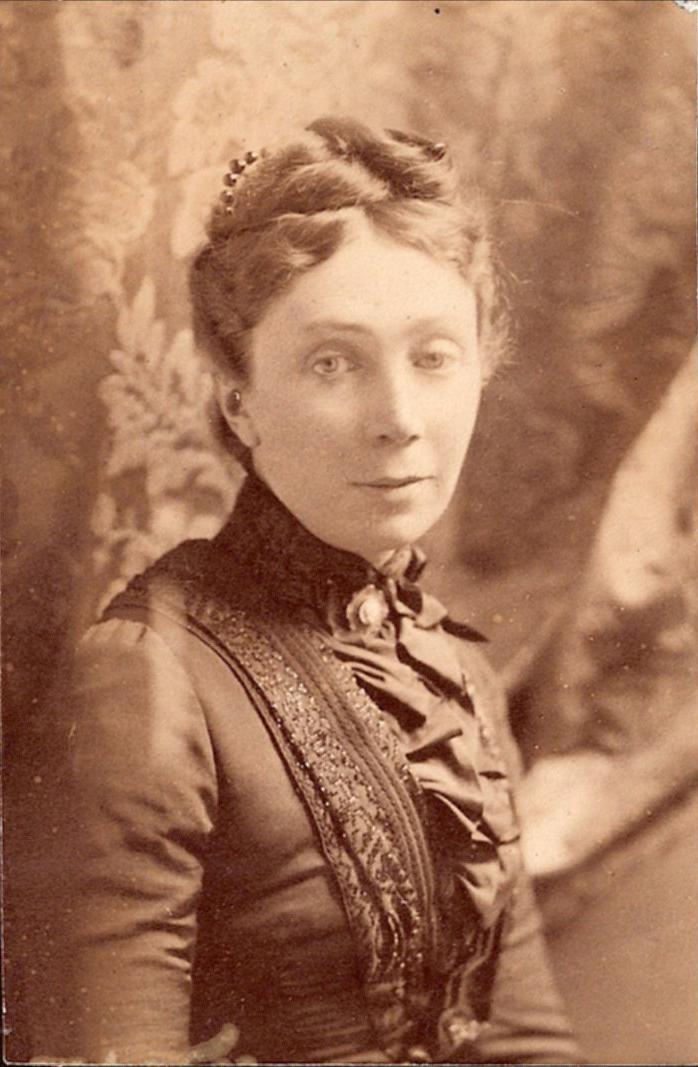
Elizabeth Welsh taken by Henry Van der Weyde of Regent Street, London, 1885 (archive reference GCPH 5/6/3).
Early Life
Elizabeth Welsh was born on 31 July 1843 in County Down. Her father, John Welsh of Granshaw, was a descendent of John Knox, the leader of the Scottish Reformation. Her mother was Eliza (sometimes also called Elizabeth) Dalzell. Elizabeth was the eldest of four daughters. She was educated at home and attended classes given by Rev James Rowan, Presbyterian Minister of Kircubbin. Elizabeth was later to describe him as one of the ablest men she had ever known. At the age of 15 she attended a boarding school in Belfast, but with the early death of her father, and the family’s move to Portaferry, her formal education pretty much came to an end. However, desirous of something more and having seen an advertisement in the periodical, the Athenaeum, she decided to apply for a scholarship to The College for Women, Hitchin [to be renamed Girton College in 1872]. She called on the help of the village schoolmaster to help her prepare and, in the summer of 1871, she travelled to London to sit the entrance examination. She was delighted to learn that she had been awarded the second Lady Stanley scholarship.
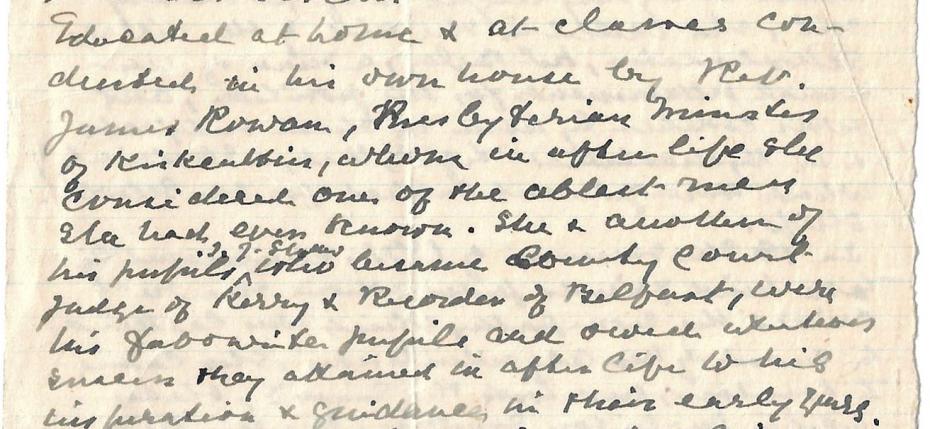
Extract from a memorandum written by Elizabeth describing the positive influence Rev James Rowan had on her life, not dated (archive reference: GCAR 1/6/2/1pt).
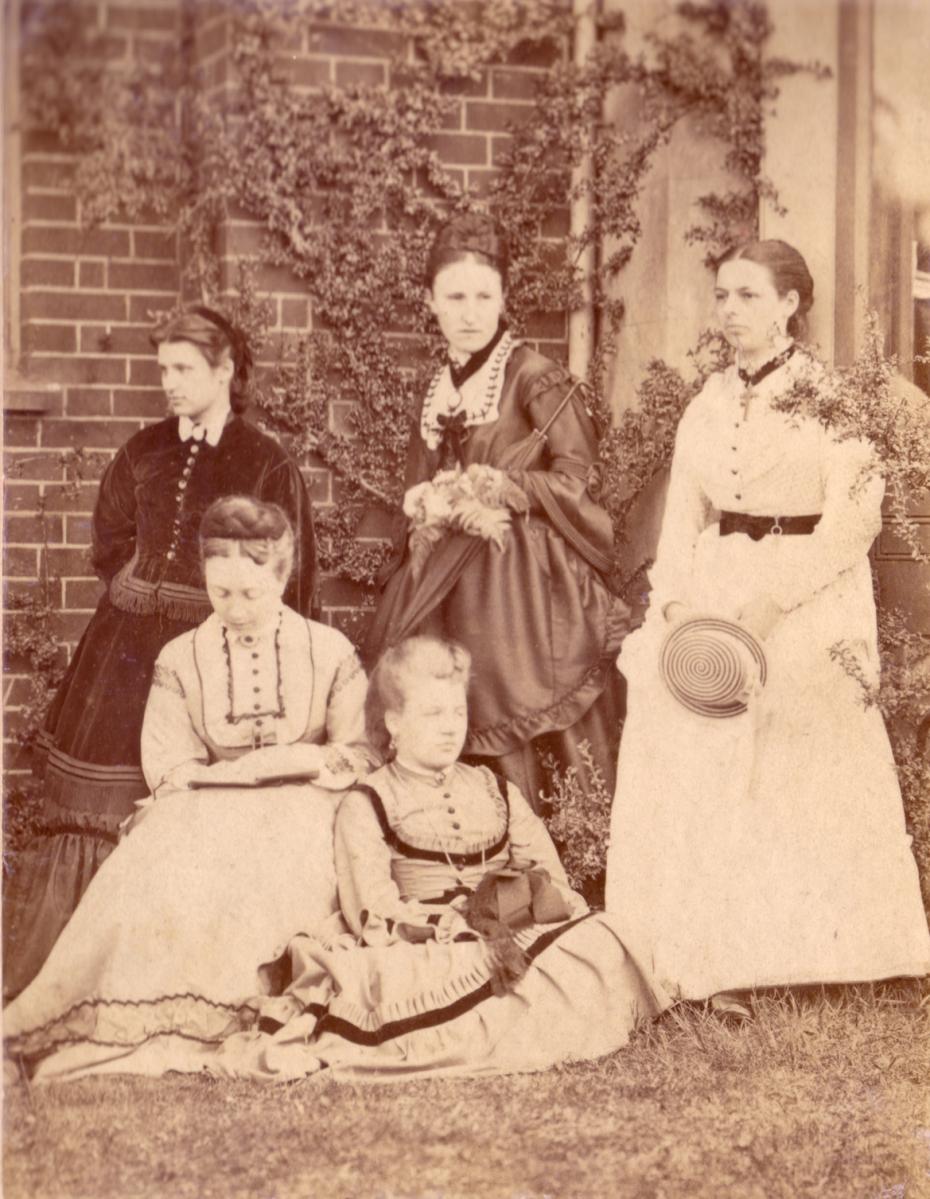
Photograph of the first year students, taken by an unknown photographer,1871 (archive reference: GCPH 10/1/4). Elizabeth is pictured in the front row, on the left hand-side.
The College for Women, Hitchin and Girton College, 1871–1875
Elizabeth joined the College at Hitchin in 1871, when she was aged 28. She was part of the College’s third intake of students and she moved with the College in 1873 to Girton. As a student she was diligent and hardworking, and was seen by her peers as very serious and obedient. She was great friends with Rose Aitken (1848–1923, Girton 1871), who had been awarded the first Lady Stanley scholarship, and they studied together for the Classical Tripos, immortalised by Constance Maynard (1849–1935, Girton1872) in her sketch ‘Girton’s History Anticipated’. It was Constance who nicknamed her ‘the good student’.
However, her fellow students also knew Elizabeth for her ‘delightful humour’ and warmth. She was renowned for writing several of the early College songs and verses, including 'A White Sheet', 'Sonnet to Girton College' and ‘Girton, my Friend'. She also participated in the early College societies. The first Shakespeare play chosen by the Shakespeare Reading Society was Othello, in which Elizabeth took the part of Lago. She was also a founder member of the bible reading society started by Constance Maynard.
In March 1875 she passed the Classical Tripos.
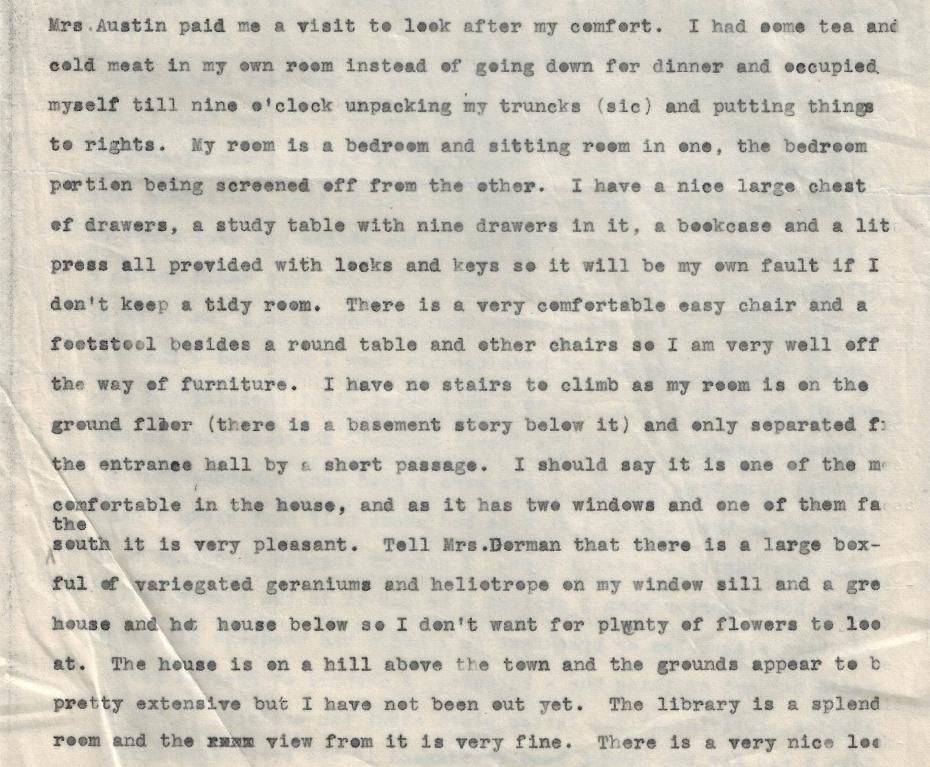
Typed copy of an extract from a letter from Elizabeth to her mother, describing her room at Benslow House, Hitchin, 1871 (archive reference: GCAR 1/6/2/2pt).
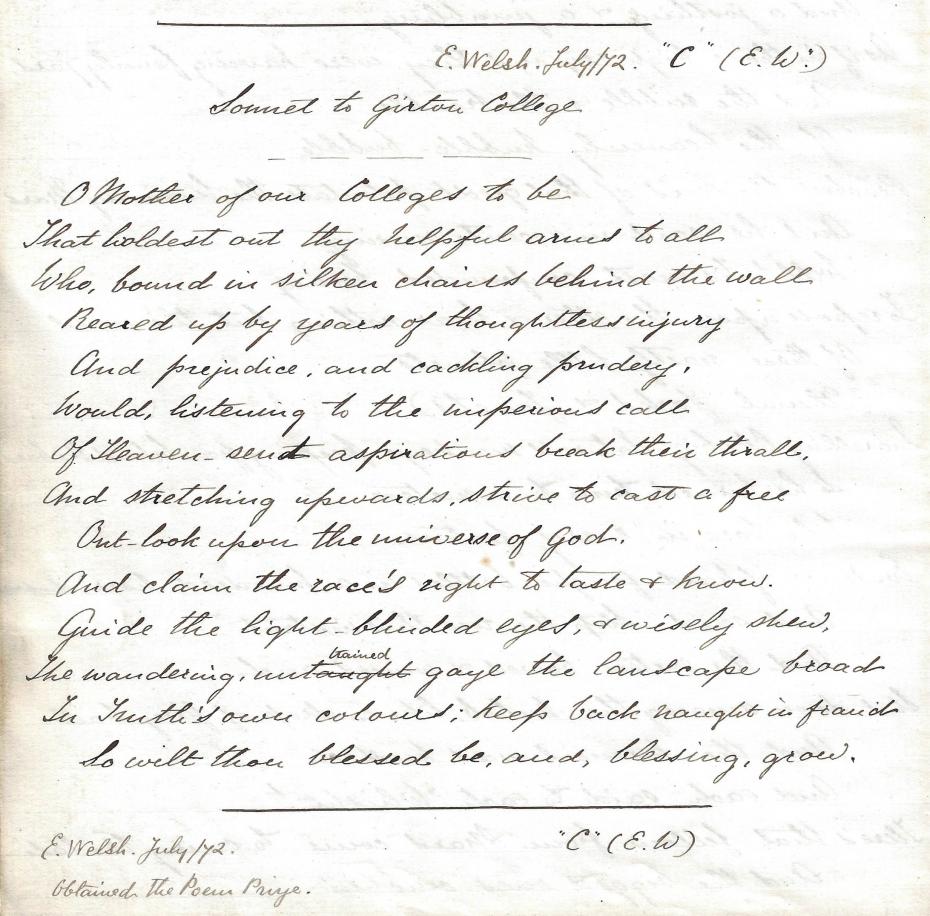
Sonnet to Girton College by Elizabeth Welsh, 1872 (archive reference: GCRF 7/1/2pt).
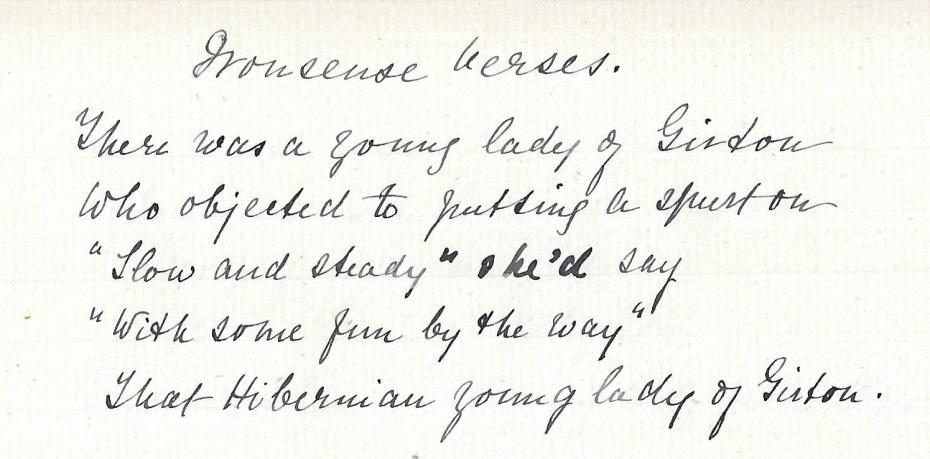
Nonsense verse by Elizabeth Welsh, not dated (archive reference: GCRF 7/1/3pt).
Constance Maynard’s diaries are held by the Queen Mary University of London Archive. Her ‘green book’ diaries and autobiography have been digitised and are available here: https://www.qmul.ac.uk/library/archives/digitised-records/constance-maynard/
Resident Assistant Lecturer in Classics, 1876–1884
After passing the Classical Tripos, Elizabeth spent one year as a school-mistress at Manchester High School, before Marianne Bernard (1839–1926, Mistress 1875–1884), suggested she be appointed Girton’s Resident Assistant Lecturer in Classics. In this appointment she was, among other things, ‘to help the first year students in what they often have to encounter, namely the difficulties of actually beginning a language’. Miss Bernard liked Elizabeth very much, finding her hard-working, sensible and inclined to take direction without too many questions.
One of her tasks as Resident Lecturer was chaperoning groups of students going into Cambridge. She regularly accompanied small parties to Cambridge University Musical Society’s evening rehearsals and concerts. The students were frequently mortified because Miss Welsh usually made them leave early, so they could be back in Girton before the gates were locked.
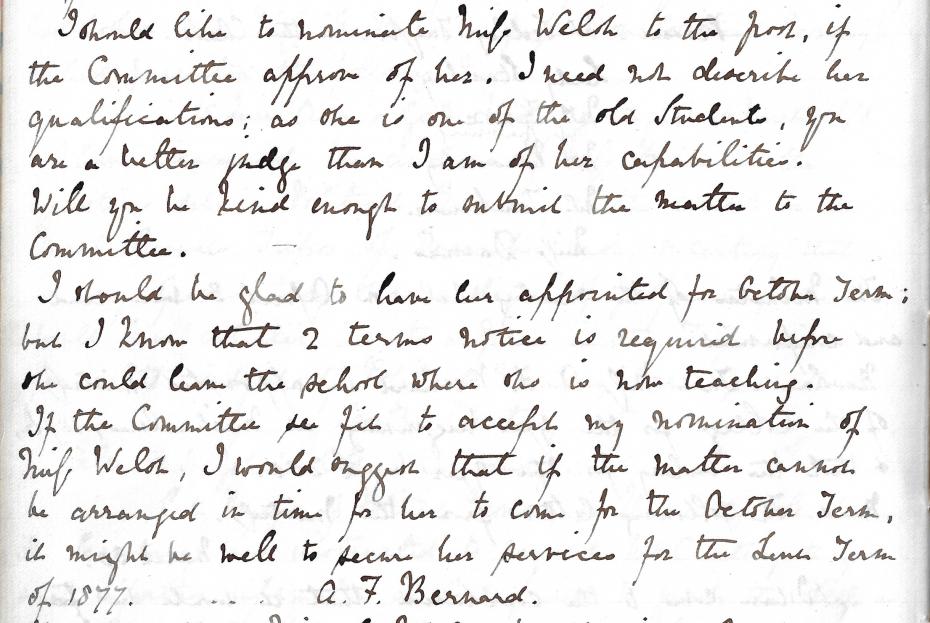
Miss Bernard recommends Elizabeth Welsh to be appointed as the College’s Resident Lecturer in Classics, from the Executive Committee minutes, 28 April 1876 (archive reference: GCGB 2/1/4pt).
Vice-Mistress, 1881–1885
In 1881, Elizabeth was appointed Vice-Mistress. She was the first to hold this office and her duties as set out in the Executive Committee minutes were to reside at the College during July and August, and to give such assistance to the Mistress as required.
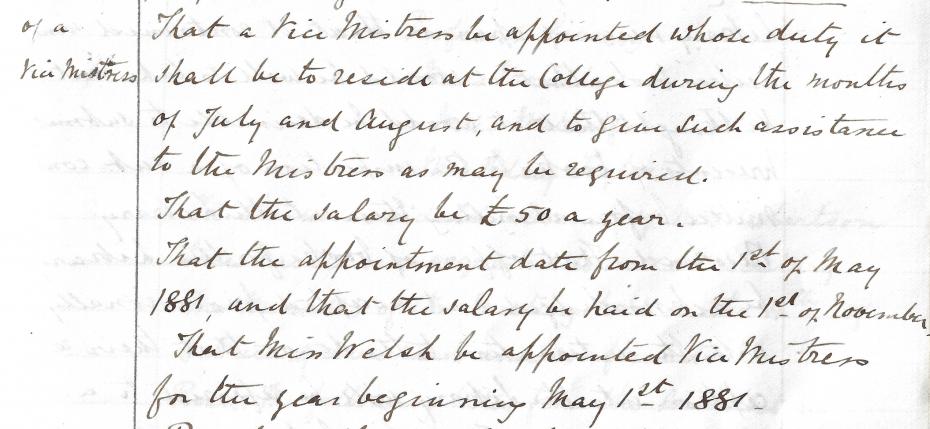
Elizabeth Welsh appointed as Vice-Mistress, from the Executive Committee minutes, 4 February 1881 (archive reference: GCGB 2/1/6pt).
Garden Steward, 1883–1903
In 1883, Elizabeth was appointed Garden Steward, and it was under her care and attention that the College grounds began to take the shape that we recognise today. In 1884, the pond was created when gravel was required for the building of the Stanley Library and Orchard Wing. It was Elizabeth who suggested deepening it to ensure there was enough water in case of fire; she then built up the bank and planted it with shrubs. This also meant she could use the additional gravel excavated for her new pathways in the grounds. She planted trees along the edge of the grounds to provide shelter from the biting wind, and planted Honeysuckle Walk in 1884. In 1886, when the College purchased 17 additional acres, Miss Welsh completed the Woodland Walk, adding shrubs and trees to the lawn, effectively creating a miniature park.
She was also responsible for the planting of the Orchard, now known as the Old Orchard, to provide fruit for the College. Originally, she intended the Orchard to be on the eastern side of the pond but, realising this land was better suited to growing vegetables for the increasing numbers of students, she selected the site on the western side of the pond. The planting of the Orchard was completed in the spring of 1893.
At this time there was no College Garden Committee and only a few reports written by her as Garden Steward exist; however, her plans and requests are detailed in her letters to Miss Frances Kensington (1851–1931, College Secretary 1882–1897 and Bursar 1894–1897) and in the Executive Committee minutes. From these records it is apparent that she also took pride in the detail of the garden. This can be seen in her carefully considered drainage system, her requests to improve the tool shed and pigsties and to replace gates and fences, and her meticulous garden accounts.
As the gardens began to take shape, former students and College supporters were generous in their gifts of plants, shrubs, trees and even, in 1894, a pony to help with the garden work. Miss Welsh herself also gifted 60 tea roses ‘of good kinds’. Barbara Stephen (1872–1945, née Shore Smith, later Shore Nightingale, College Secretary 1897–1903) remembered that when she was a student, 1891–1894, she would see Miss Welsh’s tall figure walking the grounds with the Gardener, Bonwick, giving careful directions as to trees and shrubs. It was also Barbara Stephen who recounted how Miss Welsh would go onto the roof of the Tower to survey the grounds and plan her planting schemes.
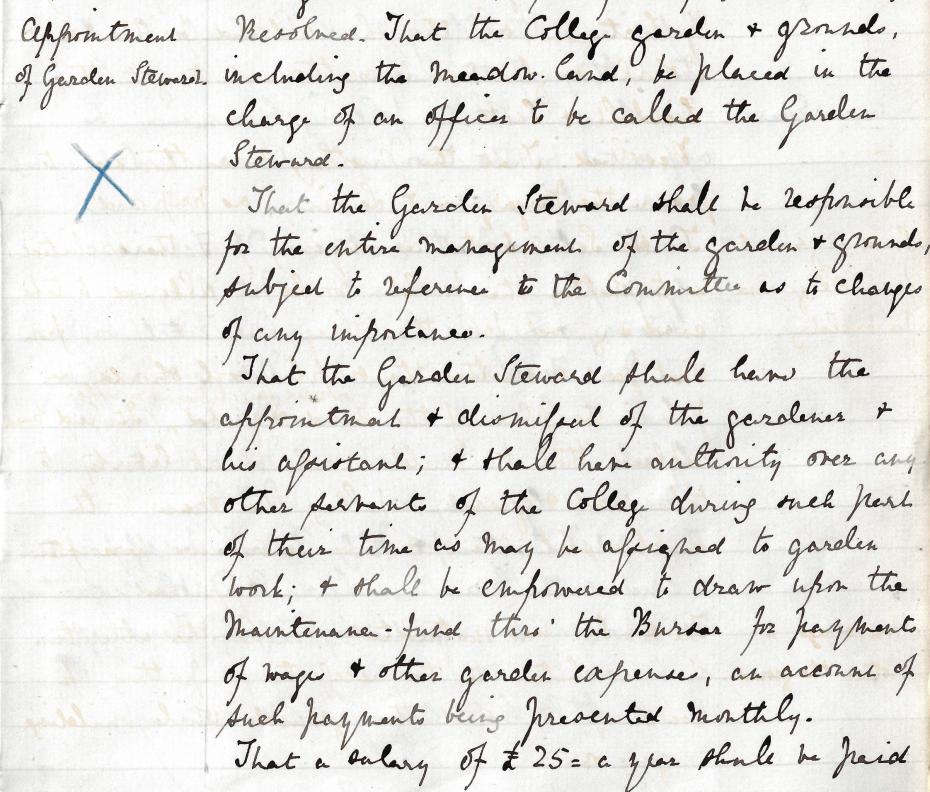

Duties of the Garden Steward and Elizabeth Welsh’s appointment, from the Executive Committee minutes, 2 February 1883 (archive reference: GCGB 2/1/8pt).
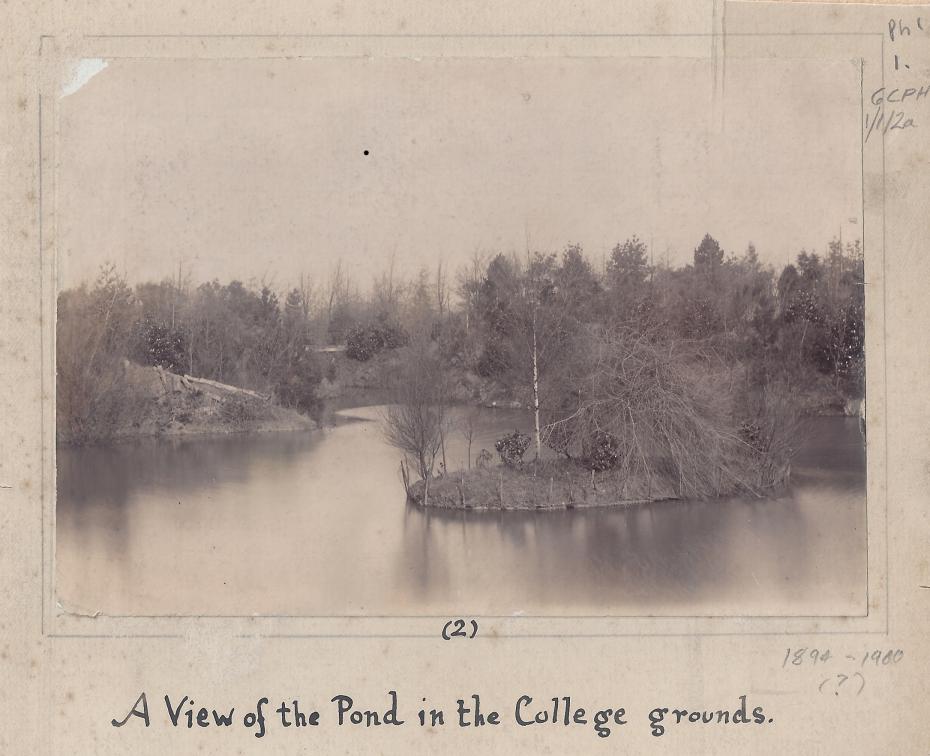
Early photograph of the pond, taken by an unknown photographer, circa 1894 (archive reference: GCPH 1/1/2).
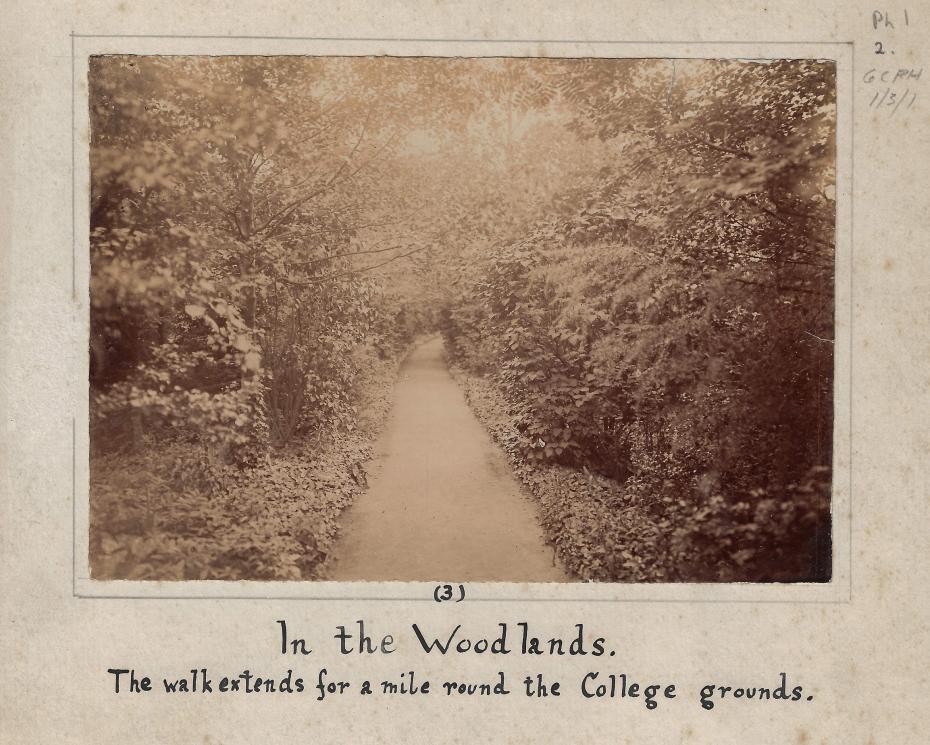
Early photograph of the Woodland Walk, taken by an unknown photographer, circa 1897 (archive reference: GCPH 1/3/1).
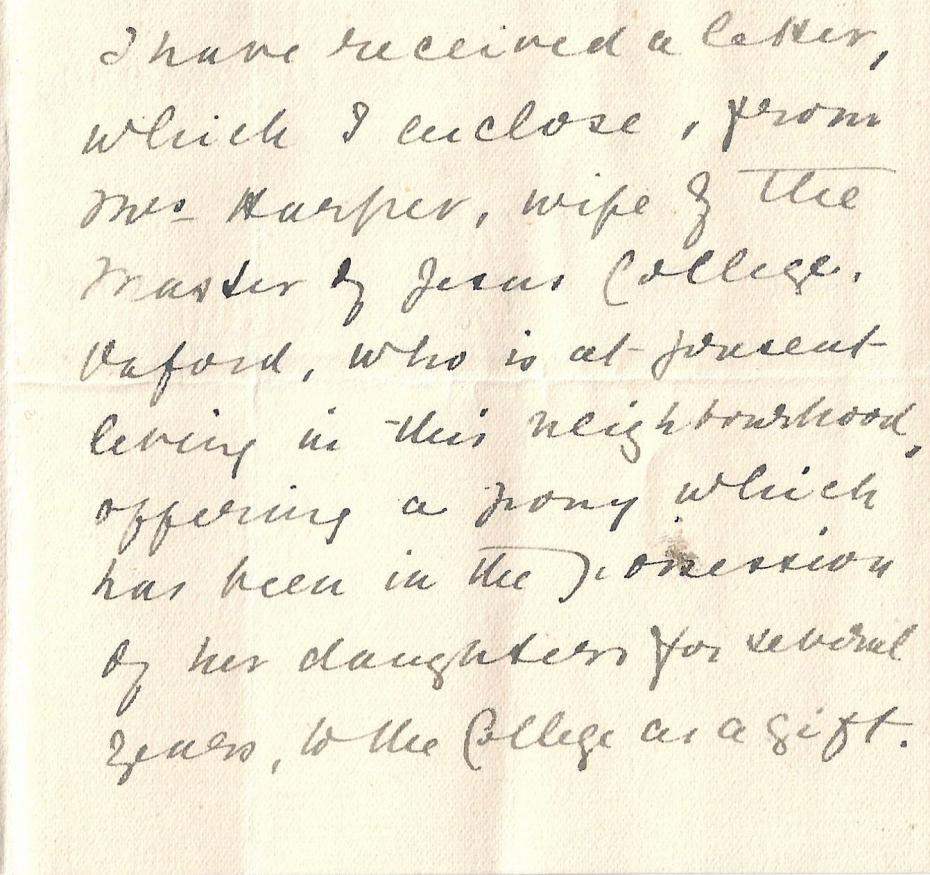
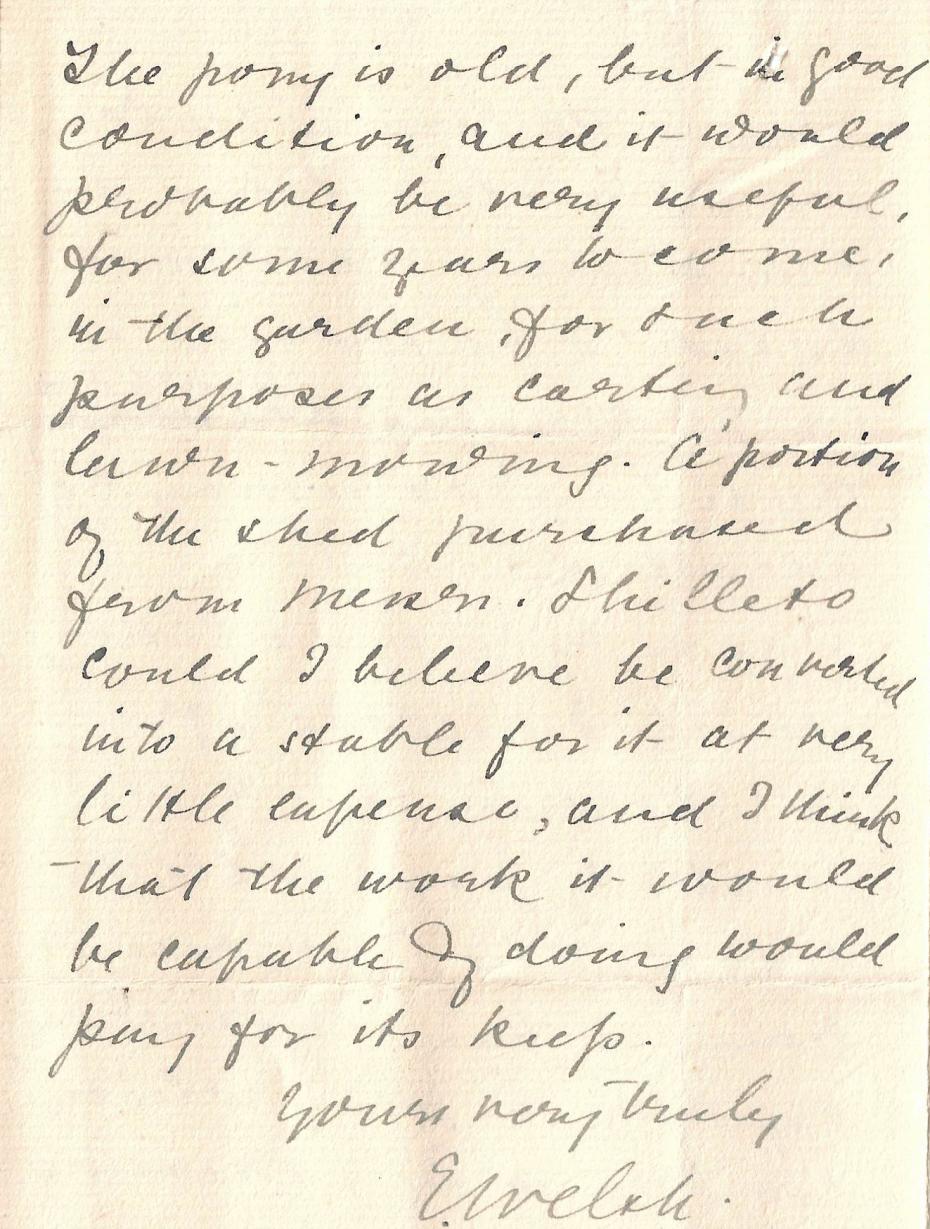
Extract of a letter from Elizabeth Welsh to Miss Kensington, reporting the gift of a pony, 24 September 1894 (archive reference: GCAR 1/6/4/4/pt).
Mistress 1885–1903
In 1884, Miss Bernard resigned her post of Mistress in order to marry Dr Latham. Miss Welsh was asked by the Executive Committee to step in as Mistress whilst the post was advertised. There then ensued a battle behind the scenes over who should be the next Mistress. Emily Davies (1830–1921, one of the College’s key founders) was adamant that Miss Welsh should be appointed but other members of the Executive Committee preferred Louisa Lumsden (1840–1935, Tutor in Classics 1873–1875), one of the first students at The College for Women, Hitchin. To settle the matter, there was a close-run vote in the Executive Committee; Emily Davies prevailed and Miss Welsh became Mistress in 1885. By all accounts Elizabeth and Louisa remained on good terms, with Louisa visiting her later in life when she was in Edinburgh.
As Mistress, Elizabeth was very hardworking and committed to the College. After her appointment as Mistress, she was made a member, although not ex officio, of the London-based governing committees of the College. As such she was the first Mistress to take some part in College governance and policy making, although she was not inclined to challenge Emily Davies. As a result, Emily continued to take the lead in College affairs across Elizabeth’s time as Mistress and it was left to the younger members of the Staff to challenge Emily’s authority.
Under Miss Welsh’s Mistress-ship the College saw dramatic growth in both the buildings and student numbers. In 1887, the Tower and Tower Wing were added, but it was the building programme of 1899–1901 that saw the major growth, with the addition of the Dining Hall and kitchens, Cloister corridor, the Chapel and Chapel Wing, Woodlands Wing and the swimming pool. The student numbers increased in step with the buildings. In 1885, when Miss Welsh became Mistress, there were around 70 students, but by 1903 this number had increased to around 130 students.
By all accounts Miss Welsh was firm with the students, slightly old fashioned in her outlook and very particular about following the rules. If a student broke a College rule, they were summoned to her room by a note under their door. When Dorothy Howard (1881–1968, Girton 1901) was summoned in this way in May 1901, she noted that when she arrived at 9am there was already a queue waiting outside Miss Welsh’s room. However, the students seemed fond of Miss Welsh. Her testimonials became celebrated among the students. She also continued the tradition of holding parties at the College, to which Cambridge friends of the College, and the lecturers and their wives, were invited. These were much enjoyed by the students and those in Cambridge. In 1891, a Mrs Myer wrote that Miss Welsh’s parties were always the nicest of the year.
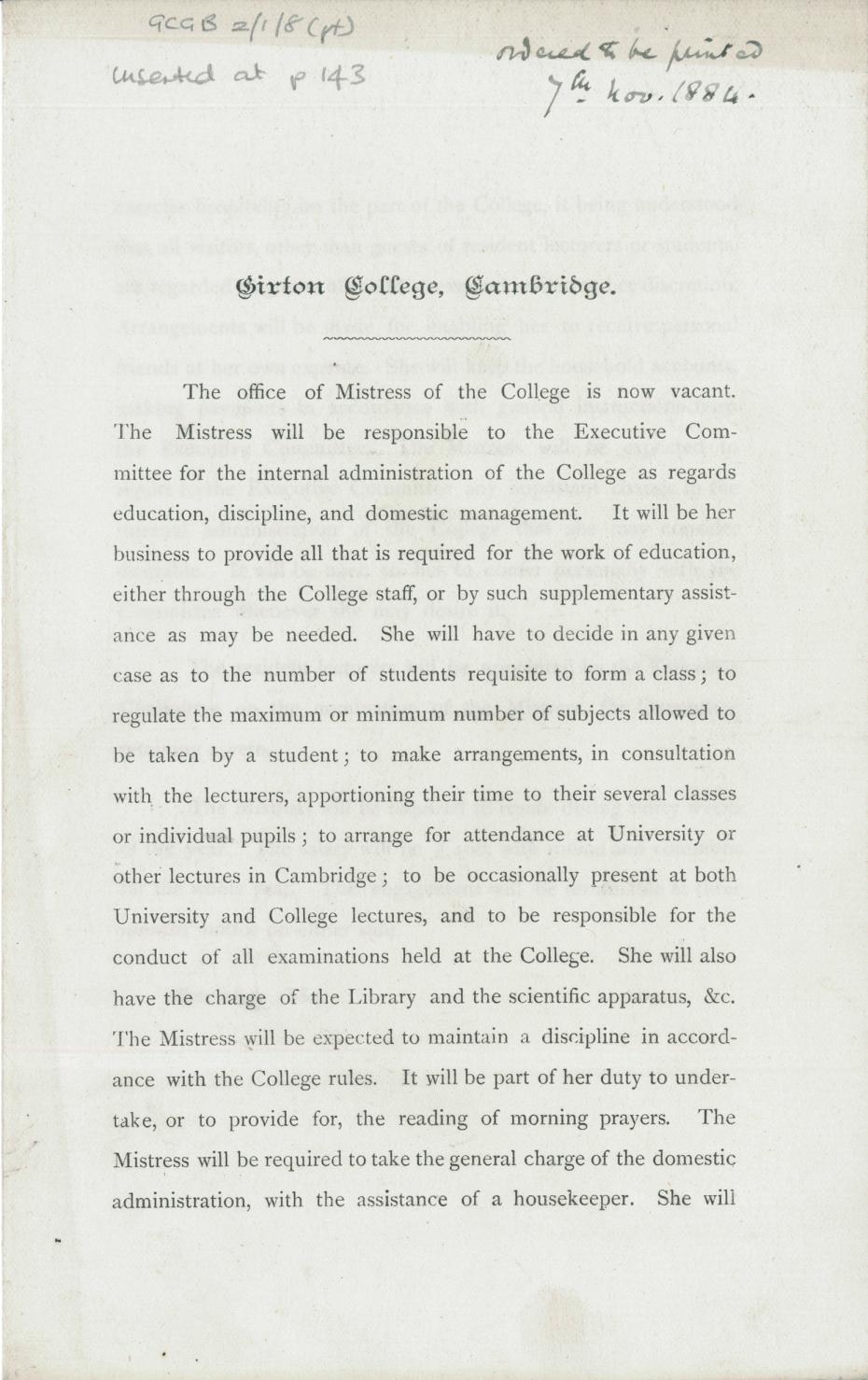
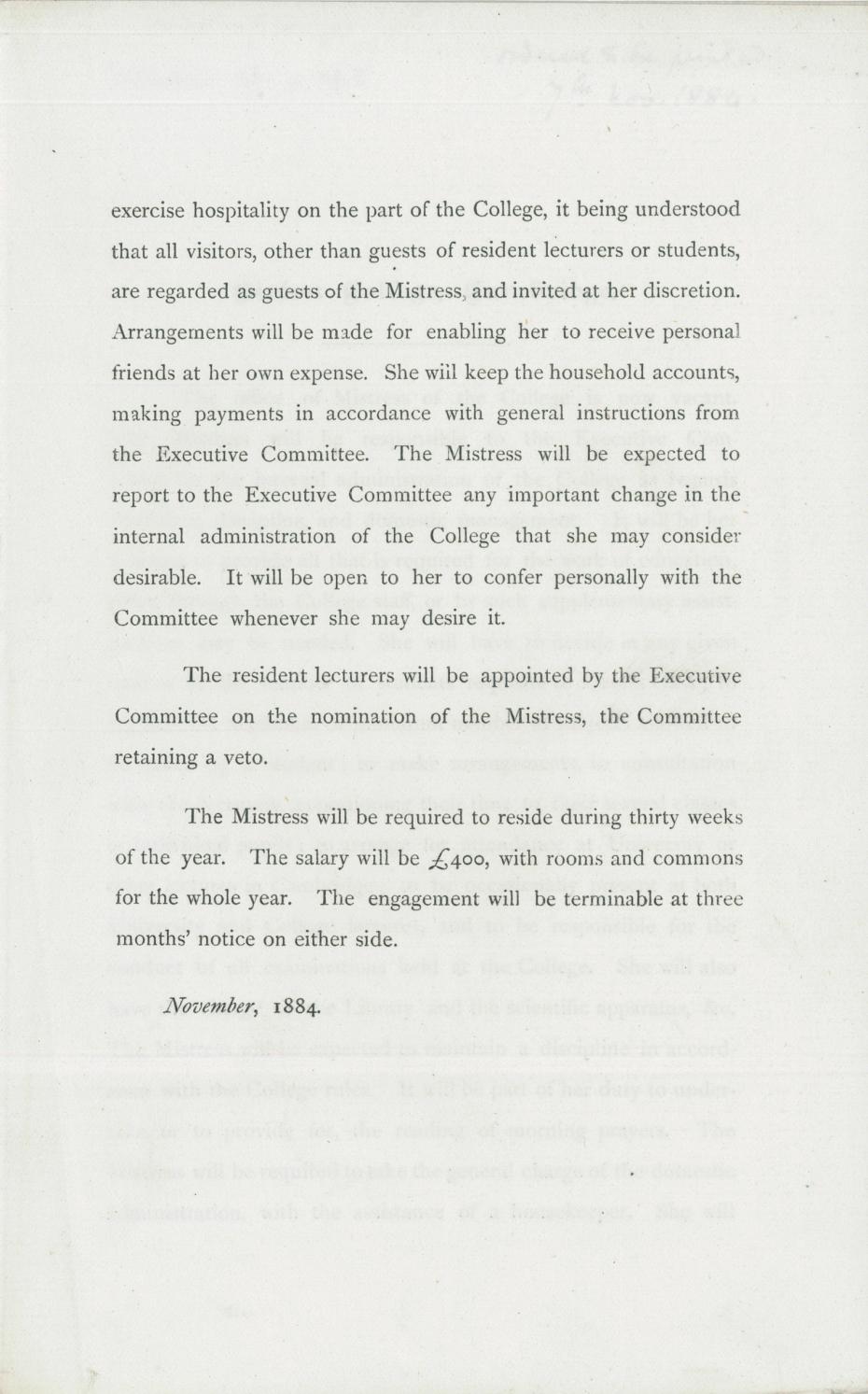
Printed duties of the Mistress, 1884 (archive reference: GCGB 2/1/8).
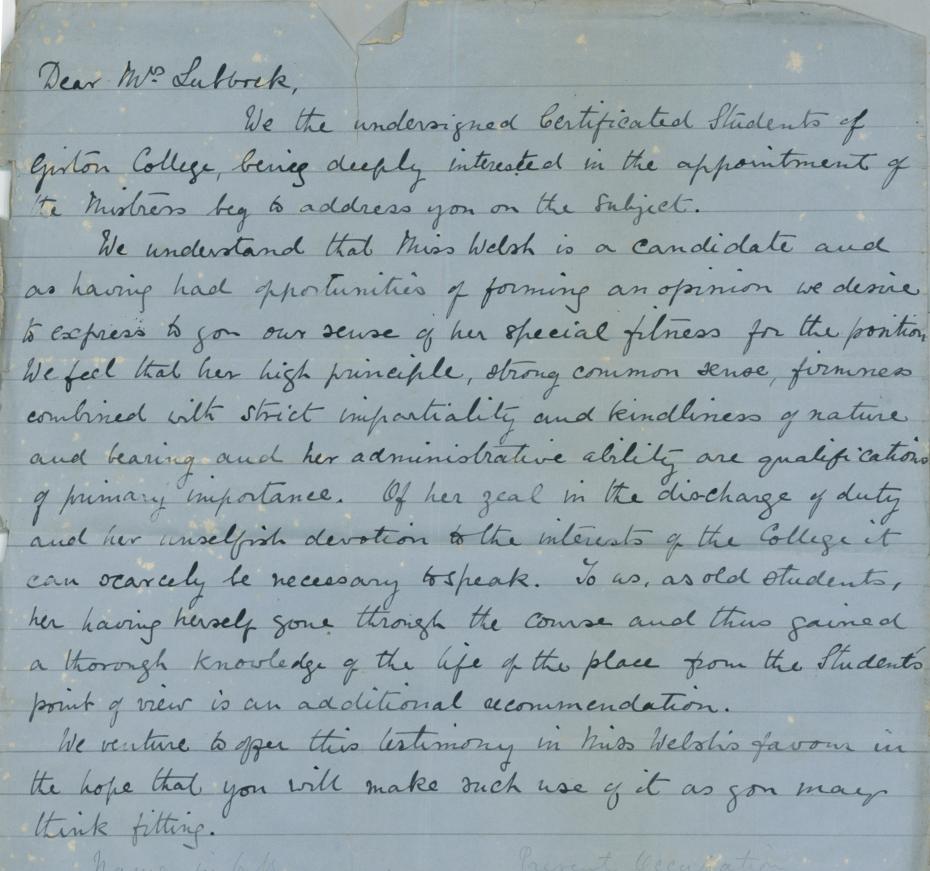
Petition in support of Elizabeth Welsh as Mistress signed by some of the old students, circa 1885 (archive reference: GCGB 1/6/2).
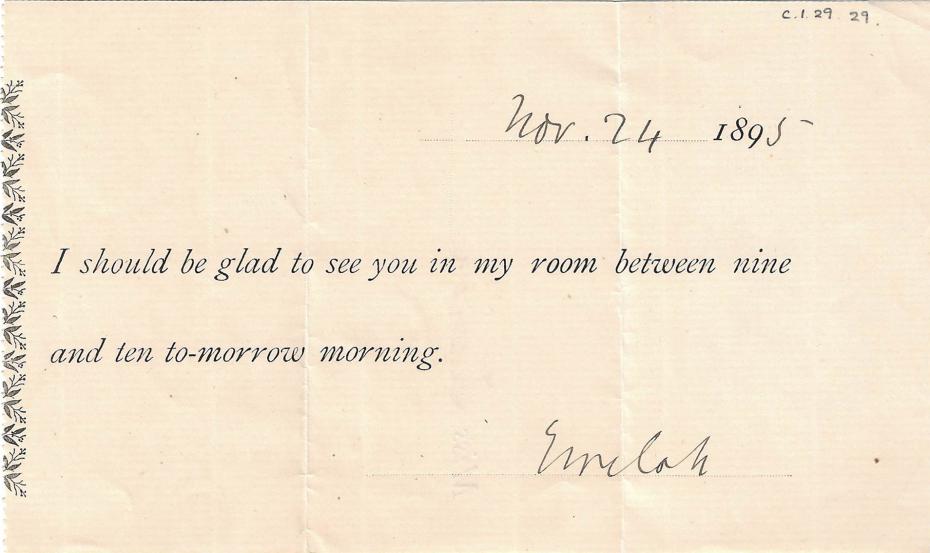
‘Invitation’ to Miss Lynch (Muriel Lynch, 1875–1955, Girton 1894) to visit Miss Welsh’s room, 24 November 1895 (archive reference: GCPP Taylor pt). The context of this summons is not known.
Elizabeth Welsh’s retirement
In 1902, Miss Welsh wrote to the Committee tendering her resignation. She left, after 18 years as Mistress, in June 1903. This news was met with real regret by both past and present students, who decided to commission and pay for a portrait of Miss Welsh. A collection was started by a Committee of the College’s Association of Certificated Students, the fore-runner of the Roll, and just over £500 was raised. Over 200 women subscribed, giving anything from 4 shillings to £3 each. Miss Welsh sat for Sir John Lavery (1856–1941) in the summer of 1904, and her portrait was presented to her at a ceremony held at Notting Hill High School in London (where the Headmistress, Ethel Gavin (1866–1918, Girton 1885), was a former student) and attended by many of those who had subscribed. Miss Welsh immediately handed over ‘her rights’ in the painting to Miss Jex-Blake (1860–1951, Mistress 1916–1922), who represented the College. In her speech, Miss Welsh expressed her heartfelt thanks at the ‘honour’ she felt that former students thought her ‘worthy of having my portrait painted for the College’.
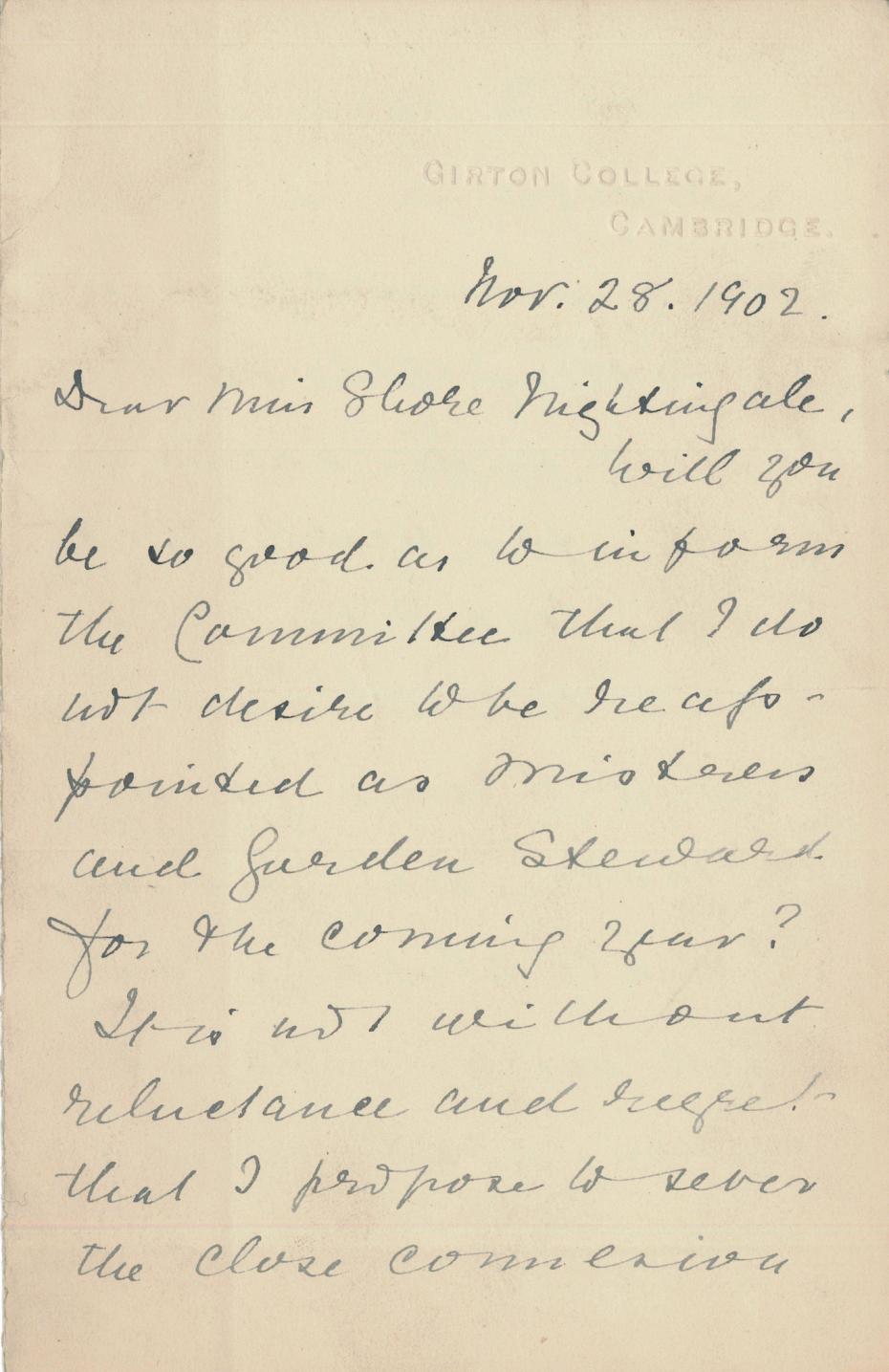
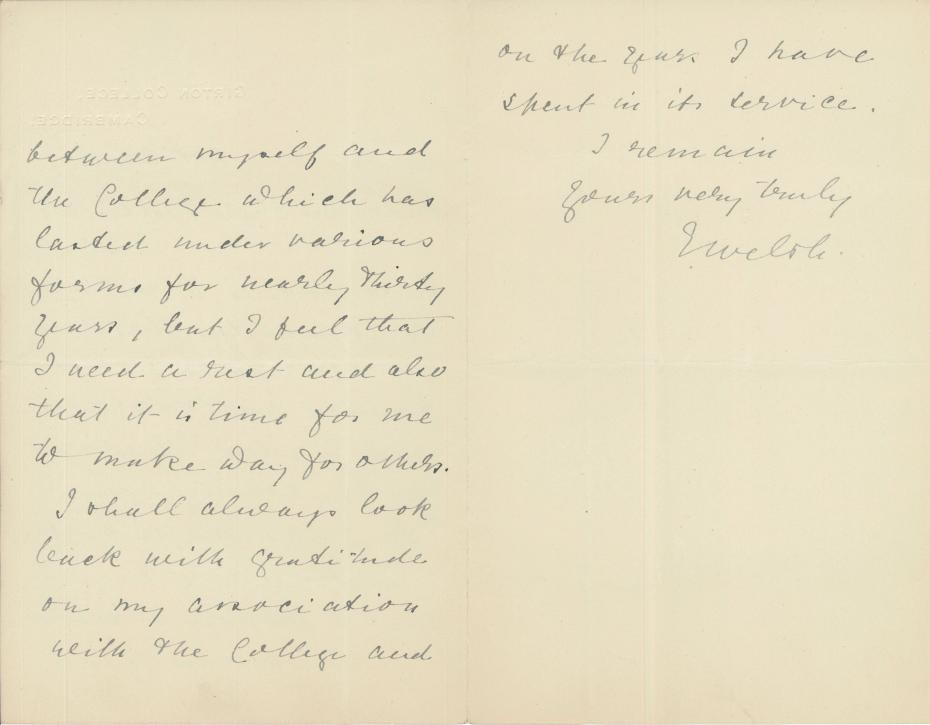
Elizabeth Welsh’s letter of resignation, 1902 (archive reference: GCGB 2/5/6/1/3pt).
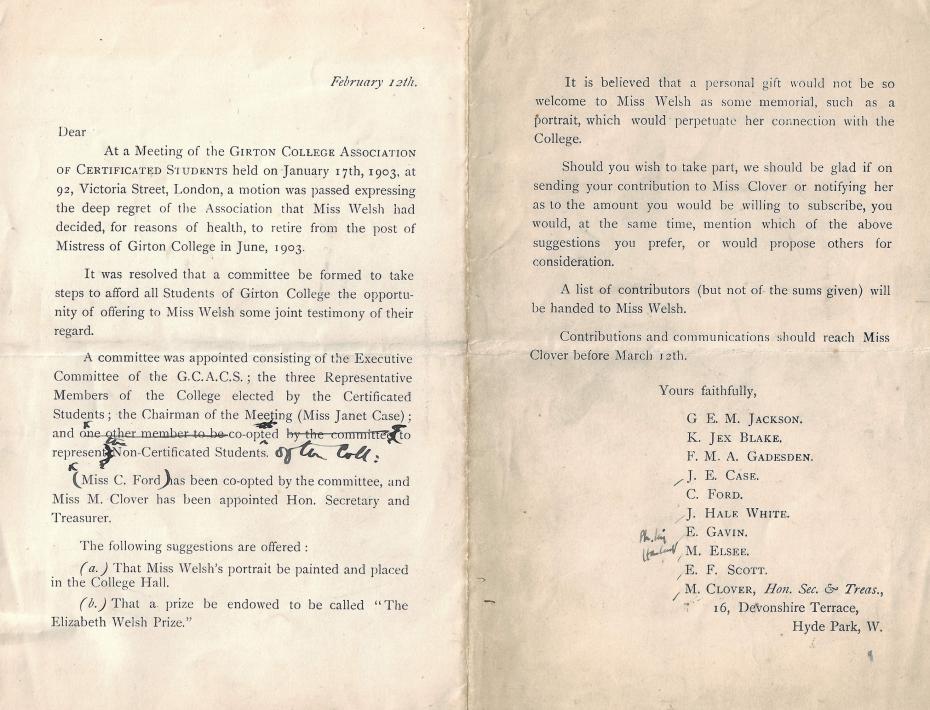
Circular letter asking for contributions to Elizabeth Welsh’s portrait fund, 1903 (archive reference: GCAS 1/3/1pt).
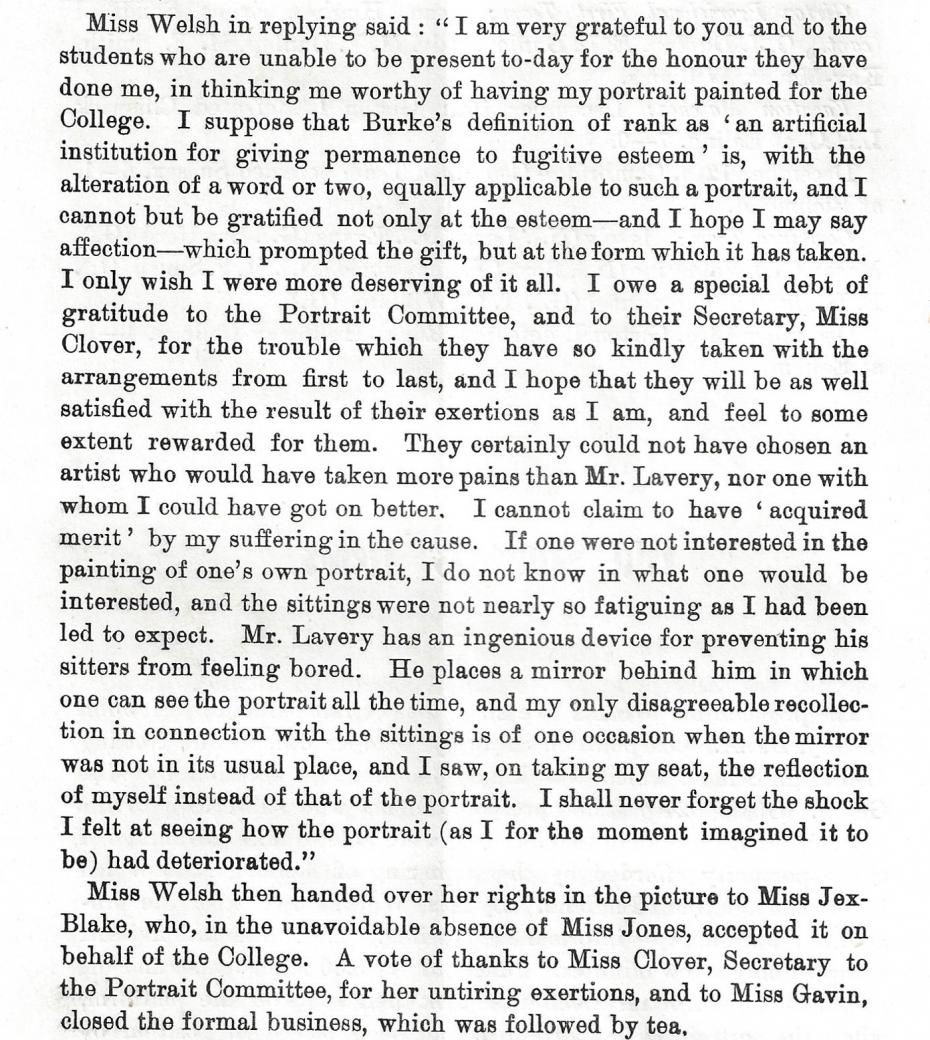
Elizabeth Welsh’s acceptance of her portrait, reported in the Girton Review, October 1904 (archive reference: GCCP 2/1/1pt).
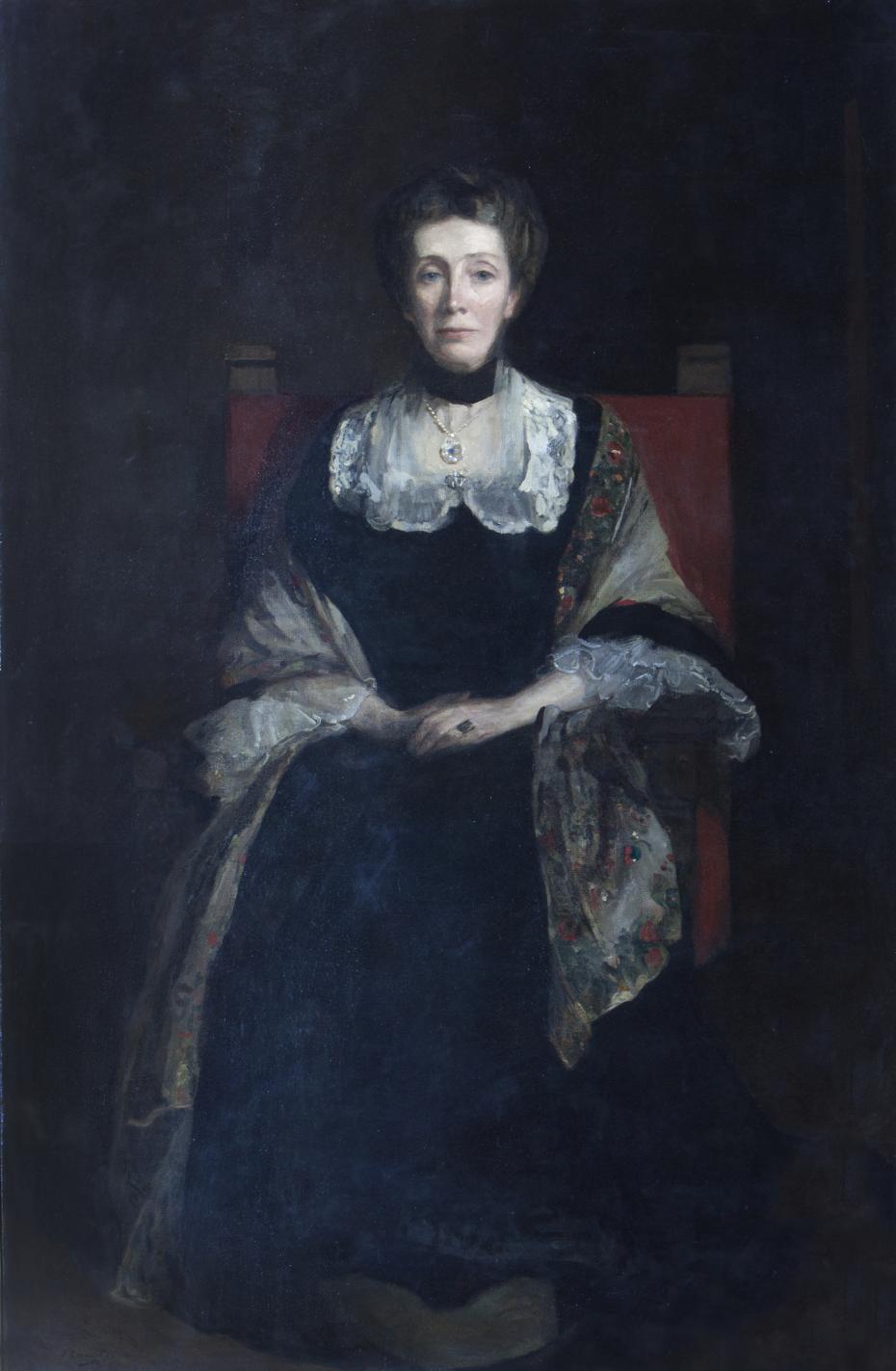
Portrait of Elizabeth Welsh by Sir John Lavery, 1904 (archive reference: GCPH 11/33/50). This portrait was displayed at the Exhibition of the International Society of Sculptors, Painters and Gravers in London, 1905, and then at the Salon of the Société Nationale des Beaux Arts in Paris, 1905, before coming to the College. It was generally admired at both exhibitions.
Life in Retirement
It appears that once Elizabeth left Girton she went travelling for a period. The Girton Review, October 1903 issue, reported that she had reached Cairo. This explains the Archive’s otherwise intriguing photograph of her on a camel. Nevertheless, Miss Welsh did not sever all her connections with the College as she continued to be a member of College up to 1916. Her letters to Miss Clover (1876–1965, College Secretary 1903–1933) during this period shows how she was still very much interested in College affairs. However, in 1916 she decided to resign her membership.
It appears that she lived for a time in Lyme Regis, before eventually moving to Edinburgh, where her garden was one of her chief pleasures. It was here on 13 February 1921 that she died. It was Katharine Jex-Blake who wrote in March that ‘Miss Welsh was a regular attendee of the Parish Church in the [Girton] village, where her many kindnesses are still gratefully remembered by the older people. This makes me think that there could be no more appropriate resting place for her ashes than the village churchyard …’. This duly went ahead and for several years the College’s Garden Committee, established in 1916, tended her grave.
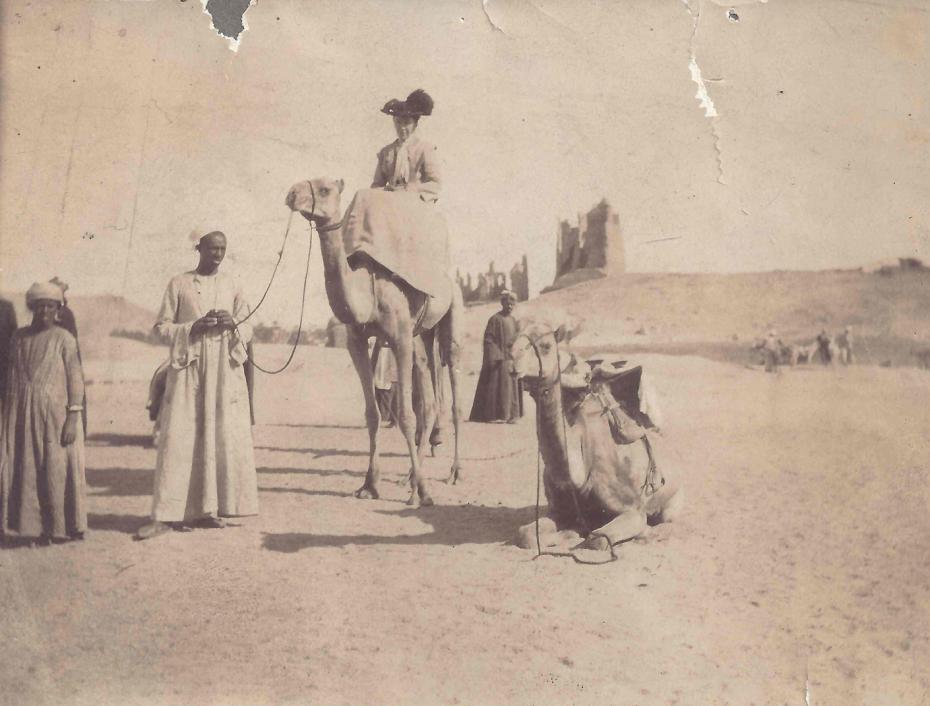
Elizabeth Welsh on a camel, circa 1903 (archive reference: GCPH 5/6/4).
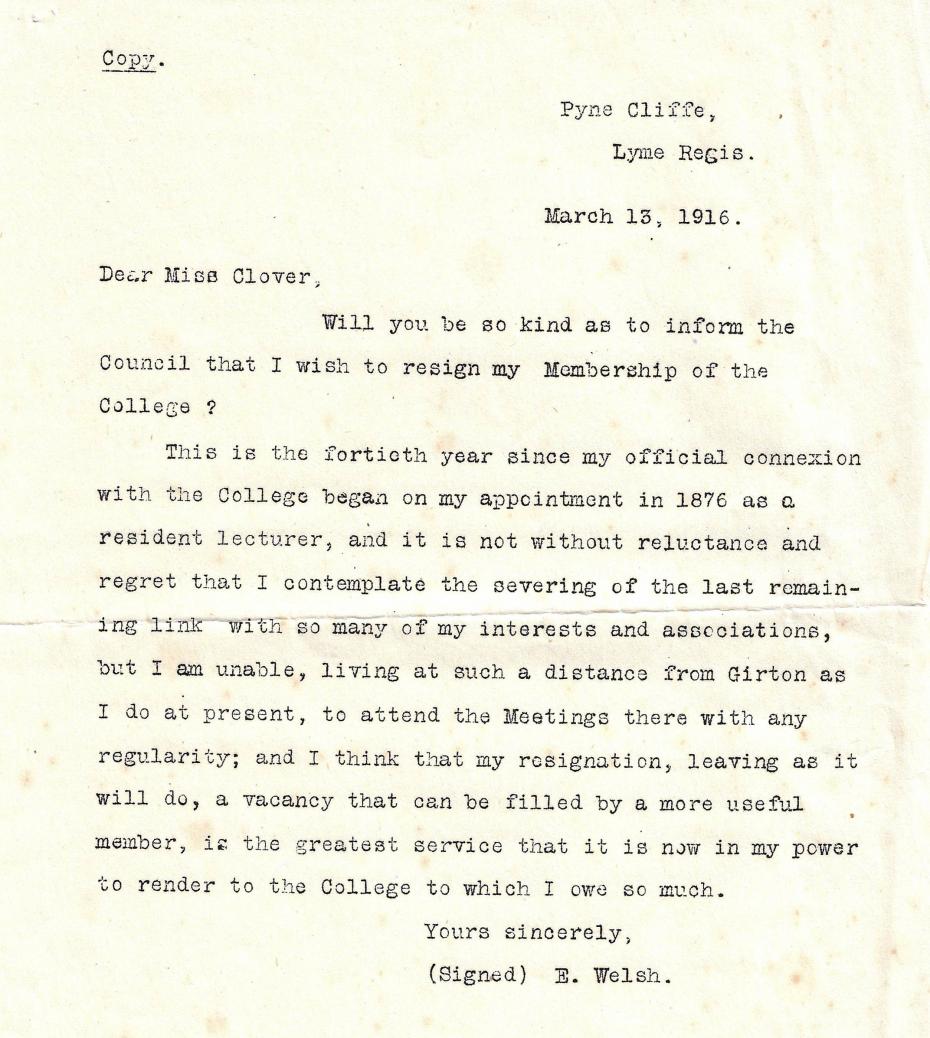
Typed copy of Elizabeth Welsh’s letter of resignation, 1916 (archive reference: GCAR 1/2/6/8pt).
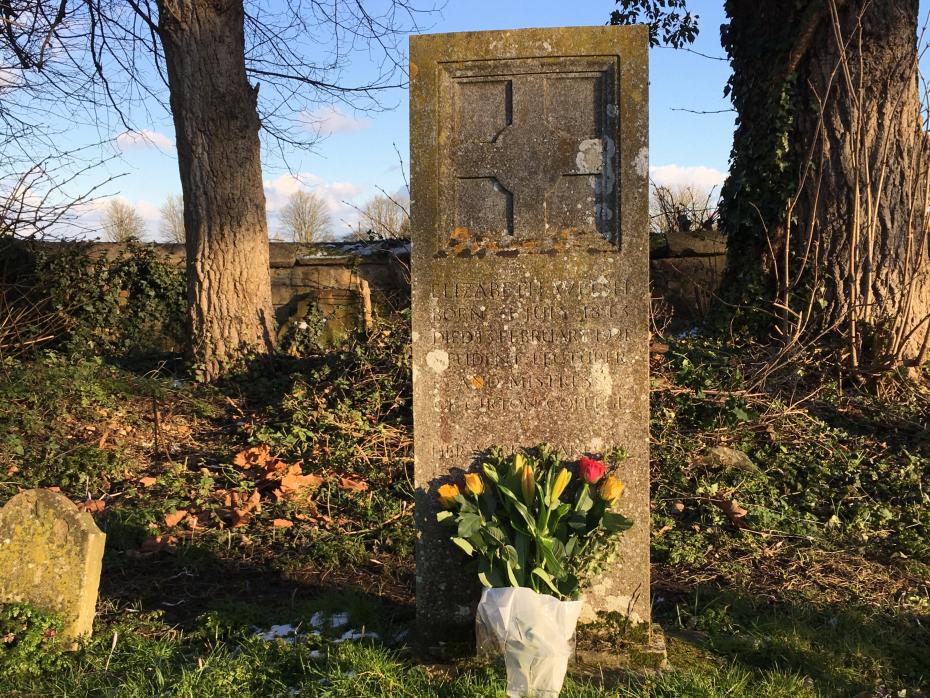
Elizabeth Welsh's headstone at St. Andrew's Church, Girton. Photograph by Jeremy West.
The headstone inscription reads:
"Elizabeth Welsh
Born 31 July 1843
Died 13 February 1921
Student, Lecturer
And Mistress
Of Girton College
Her works praise her."
The College has laid flowers on her grave, to mark the centenary of her death, and is currently seeking advice to partially to restore her headstone.
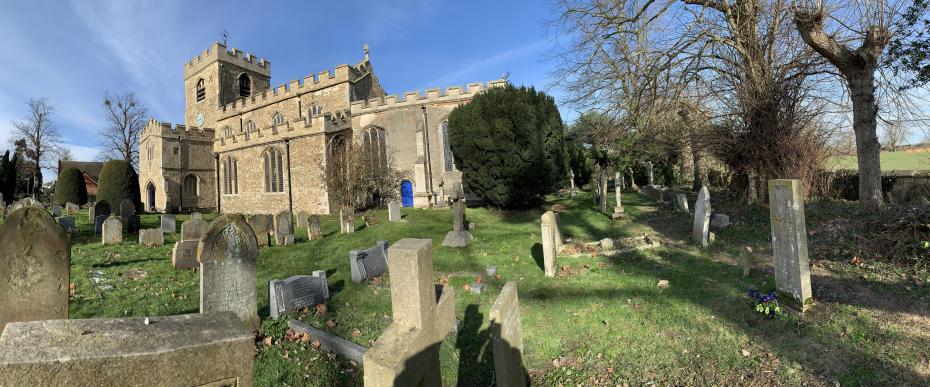
Elizabeth Welsh's headstone at St. Andrew's Church, Girton. Photograph by Lila Janik
Exhibition by Hazel Mills, College Historian, and Hannah Westall, Archivist. The facts in this exhibition are correct to our best current knowledge.
